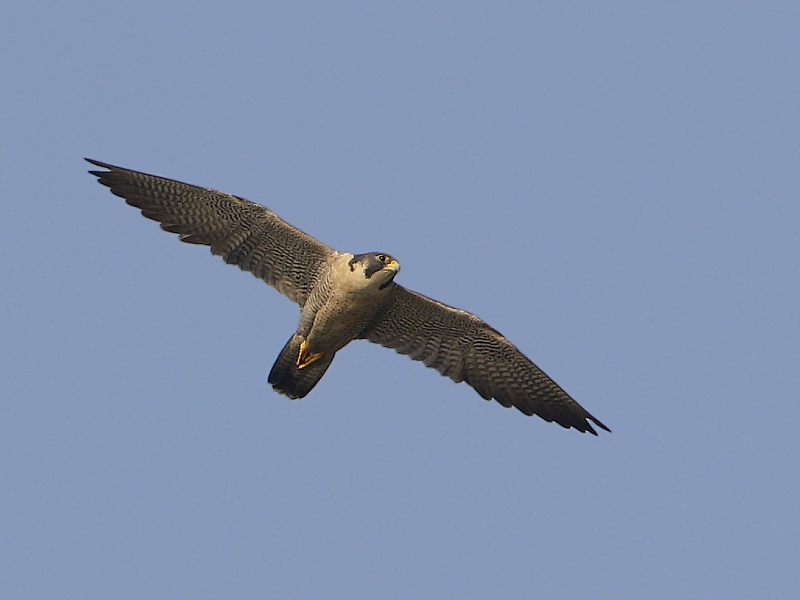| Kingdom: Animalia Phylum: Chordata Class: Aves (Birds) Order: Falconiformes Family: Falconidae |
 Peregrine Falcon (Falco peregrinus) - image © Rajiv Lather Peregrine Falcon (Falco peregrinus) is a widespread resident and winter visitor in India. They are found among high mountains, hills, stony semi-desert, ocean coasts and open wetlands near cliffs. The Peregrine Falcon is anatomically adapted for extremely swift flight. When pursuing prey, these falcons can swoop down at incredible speeds in excess of 300 km per hour! The species name, "peregrinus" (from pilgrim), means "wanderer", referring to their extensive world-wide range. Peregrine Falcons numbers plummeted through the mid to late 1900s as a result of eggshell thinning from pesticides and PCB poisoning. Fortunately, Peregrine Falcon populations have rebounded significantly since DDT was banned. Size: 40-50 cm. Identification: Peregrine falcons are about the size of a crow, with slim wings that taper to pointed tips. In flight, the wings angle back at the wrists and the wing beats are rapid. Although the plumage of male and female adults is similar, females are always larger. Adults are black, white and slate gray overall, with a white breast and heavily barred underparts. Bold "cheek-wedges" below each eye form a distinctive black helmet over the head. Juveniles are brown and beige, with dark, heavily streaked underparts. The legs are yellow and tipped in razor sharp talons, that along with the toothed-beak, are adapted to rip and tear meat. Calls: The Peregrine Falcon gives a slow, scolding and ascending "rehk, rehk, rehk" when alarmed. In aggression, a hard, mechanical "wiSHEP, koCHE, koCHE, che, che" is given. Nests: Peregrine Falcons nest on the ground in shallow, well-rounded depressions called scrapes. Females select a nest site on a ledge among accumulated debris and line it with grasses. These cliff nest-sites are used repeatedly for many years and provide a defensible nest position with a broad view. Secluded from disturbance, the nest is safe haven for the 2-6, 53 mm eggs of the clutch. The eggs are white to pinkish-creamy, and may be marked with reds or browns. Although pairs roost together, the female alone incubates the clutch for 29-32 days. The male feeds her during this time. Initially, the male does most of the hunting while the female broods and feeds the chicks. As the brood grows, the male and female hunt cooperatively. Young birds fledge in 35-42 days post-hatching. Food: The Peregrine Falcon preys chiefly on medium-sized birds, such as shorebirds, waterfowl and song birds. They take their prey in spectacular aerial "stoops" in which they rapidly dive on flying birds from above, and strike them in mid-air with a lethal blow from the talons. They also fly fast and low and use their notched beaks to kill prey by severing the spinal column at the neck. Female Peregrine Falcons are larger than males and so are able to take larger prey. When hunting cooperatively in pairs, the female dives upon prey before the male. |
 birding.in
birding.in
| Birds | Bird Diagram | Ornithology | Indian Sites | Bird Watching | Migration | North India | Birds of India | Haryana |
All rights reserved. Copyright © 2005-2013 Birds and birding in India. Disclaimer
website: Free Java Guide & Tutorials